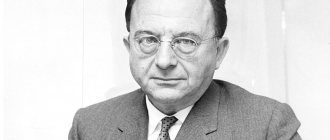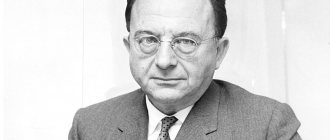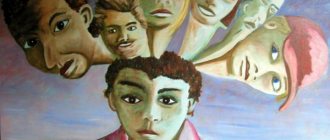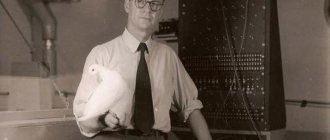Sigmund Freud
(1856 - 1939) - famous Austrian psychologist, founder of psychoanalysis - a direction that had a decisive influence on modern psychology, literature, art, medicine, anthropology, and sociology. The significance and authority of Freud's scientific work have long caused heated debate, which continues in our time.
Biography
Sigmund Freud - Austrian psychoanalyst, psychiatrist and neurologist. Founder of psychoanalysis. He proposed innovative ideas that resonate in scientific circles even today.
Sigmund Freud was born in the city of Freiberg (now Příbor, Czech Republic) on May 6, 1856, becoming the third child in the family. Sigmund's mother is the second wife of Jacob Freud, who already had two sons from his first marriage. Trade in fabrics brought the family profit, which was enough to live on. But the outbreak of the revolution trampled even such a small initiative against the background of other ideas, and the family had to leave their home. First, the Freud family moved to Leipzig, and a year later to Vienna.
A poor area, dirt, noise and unpleasant neighbors are the reasons that did not create a positive atmosphere in the house of the future scientist. Sigmund himself did not like to remember his early childhood, considering those years unworthy of his own attention.
Sigmund Freud as a child with his father
The parents loved their son very much and had high hopes for him. Passion for literature and philosophical works was only encouraged. But Sigmund Freud did not read childish, serious literature. In the boy’s personal library, the works of Shakespeare, Kant, Nietzsche and Hegel occupied a place of honor. In addition, the psychoanalyst was fond of studying foreign languages, and even complex Latin was surprisingly easy for the young genius.
Studying at home allowed the boy to enter the gymnasium earlier than expected. During his school years, conditions were created for Sigmund to unhindered completion of assignments in various subjects. Such love from his parents was fully justified, and Freud graduated from high school successfully.
After school, Sigmund spent many days alone, thinking about his future. Strict and unjust laws did not give a Jewish boy much choice: medicine, law, commerce and industry. All options, except the first, were immediately discarded by Sigmund, considering them unsuitable for such an educated person. But Freud had no particular interest in medicine either. In the end, the future founder of psychoanalysis chose this science, and psychology will become the basis for the study of various theories.
Sigmund Freud (third in the top row, left to right) as a young man with his family, 1878
The impetus for the final decision was a lecture at which Goethe’s work entitled “Nature” was read. The future philosopher studied medicine without his usual zeal and interest. During his student years in Brücke's laboratory, Freud published interesting and informative articles on the nervous system of some animals.
After graduation, Sigmund planned to continue his academic career, but the environment required the ability to earn a living. Therefore, after working for several years under some famous therapists of that time, in 1885 Sigmund Freud applied to open his own neuropathology office. Thanks to the recommendations, the scientist received permission.
It is known that Sigmund also tried cocaine. The effect of the drug amazed the philosopher, and he wrote a large number of works in which he revealed the properties of the destructive powder. One of Freud's closest friends died as a result of cocaine treatment, but the enthusiastic explorer of the secrets of human consciousness did not pay due attention to this fact. After all, Sigmund Freud himself suffered from cocaine addiction. After many years and a lot of effort, the professor finally recovered from his addiction. All this time, Freud did not abandon his studies in philosophy, attending various lectures and keeping his own notes.
Consciousness in the philosophy of Sigmund Freud and his problems
Consciousness is a special state inherent only to humans. Sigmund Freud and his supporters were among the first who tried to find an answer to the questions of consciousness, and were able to reveal behind them a world of repressed or simply forgotten by him and, therefore, already unconscious mental experiences. They were among the first to try to understand these phenomena, and through them, all the symbolic activity of consciousness. Following Freud's teachings, it turns out that the unconscious is the other side of consciousness, the psychological essence of which can only be understood through an appropriate interpretation of it. If this property of the unconscious psyche did not manifest itself in the form of symbolic images of consciousness long ago alienated from itself, that is, in the form of alienated consciousness, we would not know anything about it at all. Freud is the central figure around whom almost all theories of the unconscious are grouped, after he proposed a complete system of analysis of the human psyche up to the analysis of its hidden formations - the unconscious psyche, and this applies not only to the theories that followed him. one after another, but also theories, one after another, are drawn against him.
According to the model proposed by Freud, in the psyche of every person there are two qualitatively heterogeneous spheres: consciousness and the unconscious. Consciousness includes all mental actions that are present in our consciousness and perceived by us, and secondly, everything that is not directly given in self-consciousness. Consciousness is analogous to attention, since mental actions become conscious only if they succeed in attracting the gaze of consciousness. Freud argued that human consciousness consists of three inextricably linked parts:
- The id (it) is the unconscious part of our personality, consisting of primitive instincts and innate impulses. The key word for this part of consciousness is I want.
- Ego (I) is a buffer between our instincts and the outside world, society. The ego guides our behavior in the right direction, facilitating the safe satisfaction of instinctual needs.
- Superego (Superego) is our conscience, ethics, value system. The superego is acquired with the development of personality, during the learning process. The key words for this part of consciousness are must.
Having discovered three levels in the structure of human spiritual experience - the Super-I (paternal dogmas, traditions, ideals, conscience and other value ideas that dominate in culture), the Id (unconscious, instincts), and the Self (consciousness), Freud made an accurate diagnosis of his time, or rather, a man of his time. Excessive pressure from the Super-Ego, which does not take into account the world of unconscious human instincts, creates an inferior personality, leads people into the world of illusions about the possibility of creating human nature, correcting and changing it with purely social tricks. Freud reminded people of the existence of the Id, which is repressed as civilization develops, but does not disappear. Repressed unconscious instincts are comparable to a powder keg, ready to suddenly explode in the form of mental breakdowns as well as all kinds of social unrest. Excessive pressure from Super-I seems to provoke an increase in the power of the It. As a result, a person becomes a hostage to forces that do not obey his Self.
Referring to Schopenhauer, Freud argued that the goal of life is death, although life can and should be lived happily, you just need to learn how to direct dark impulses for the benefit of the mind
Freud rejected the philosophical tendency emanating from René Descartes that consciousness is what a person is aware of; consciousness is autonomous. Rene Descartes: I think, therefore I exist. On the contrary, according to Freud:
- consciousness is not autonomous; it is the servant of two masters - the unconscious and the unconscious;
- consciousness is unclear, unclear; consciousness is guided by one or another unconscious way.
A great power is hidden in man - the unconscious or, as he called it, the It. This force is controlled and distributed with the help of libido (lat. Libido - attraction, desire, passion) - the hypothetical psychic energy of sexual desires. The power and content of the unconscious is manifested in dreams. In addition to the Id, the structure of a person’s spiritual experience contains social norms and social attitudes, which the scientist called the Super-I. The super-ego forms a system of social filters. What does not pass through the filters of the superego enters the unconscious, is repressed from consciousness, subsequently becoming the cause of serious mental disorders. One of these reasons is the Oedipus complex - the unconscious desire of a child-boy-boy to kill his father.
Freud reduced the unconscious to two complexes:
- The first complex is the Oedipus complex, which manifests itself in a son at 3-5 years old;
- The second complex is the Electra complex (a girl’s unconscious attraction to her father and dislike for her mother at the age of 3-5 years).
In reality, Freud only recognized the Oedipus complex. Rebellion against the father and the desire to be close to the mother or even to possess her goes back to the archaic, when the sons conspired and killed their father, the ruler of a primitive tribe. Since then, the structure of the Oedipus complex has been inherited and reproduced in human spiritual experience. This sexual defect is the cause of many neuroses. Culture and the development of civilization imply endless work to wean people from their instincts. But when a culture overly suppresses instincts, they break out and destroy the culture.
The typology of overcoming conflict (methods of defense) is as follows. Suppression is the active unconscious elimination by a person of feelings, thoughts, and motives from consciousness. So socially unacceptable sexual attraction or aggression (for example, towards one of the parents) can completely take away consciousness and break through into slips of the tongue, mistakes, symbolic dreams.
In more complex situations, the reason for ingratitude, for example, may be the attribution of qualities to a person, as a result of which he should not deserve a positive attitude, and the true motive, suppressed, unacceptable, hidden for a person, is the affirmation of his Self.
Projection is the attribution of one’s feelings, desires, and inclinations to another person.
Fanaticism is ascribing to other people moral manifestations that are impossible for oneself, but subconsciously incredibly seductive; attribution to surrounding men of special sexual activity and inappropriate behavior towards themselves in a woman experiencing difficulties and dissatisfaction with communication with people of the opposite sex, etc.
Identification is the unconscious transfer of the feelings and desires of another person to oneself. This type of defense is common in children, in the process of socialization, those who learn patterns will lead significant others, as well as in adopting male or female social roles. The deep essence of such a defense mechanism is the symbolic possession of an inaccessible but desired object (as in children's games).
Sublimation is the transfer of energy from a prohibited object to any form of activity acceptable in society. Freud tended to explain creativity as the realization of such a plan of free energy; biographies of famous artists, writers, figures, scientists are options for sublimated energy.
If psychosexual energy continues to circulate in a closed circuit and is not discharged, unconsciously motivating behavior, the person experiences unpleasant experiences and anxiety. This condition can be classified as neurotic.
If we follow the logic of Freud's teachings, then there is only one way to tame the violence of the unconscious, the Id: strengthen the Super-I, strengthen the repressive function of culture and thereby put restraining barriers to the growth of the unpredictable Id. In other words, in order for the Self, consciousness, to strengthen its position, it is necessary to create a meaningful balance between two elements that influence a person and his Self: the element of supra-individual social norms and cultural attitudes - and the element of the unconscious. Otherwise, humanity risks plunging into barbarism.
Having examined various historical and philosophical traditions of interpretation of the problem of consciousness, we can draw several conclusions:
- Firstly, philosophers did not invent this or that understanding of consciousness: they reproduced the structure of human spirituality that was real for a certain era and the real place of consciousness in it.
- Secondly, the structure of spiritual experience at all times was closely related to the specific worldview of that era. Therefore, depending on which worldview was dominant—cosmocentric, theocentric, anthropocentric, sociocentric—the understanding of consciousness also changed.
- Thirdly, the deformation of people’s inner experience had a steady tendency to lower the level of spirituality. And if during the time of Plotinus and Bl. Augustine, in the structure of inner experience the priority was the level of Divine simplicity, then in modern times it was considered indecent to talk about this. God is dead and the highest level of spiritual experience is exhausted. Consciousness ceased to be understood as a reflection and function of the Divine: it began to claim to be not a function, but an independent reality, and the most obvious and reliable one, independent of anything. With the development of bourgeois relations, material interests began to dominate the structure of internal experience, and consciousness became nothing more than an awareness of these interests.
And finally, with the intensification of the processes of egalitarianization (French Egalite - equality) and liberalization (Latin Liberal is - free) and, accordingly, with a decrease in the controlling influence of society on human life, the unconscious, the It, began to dominate in the structure of spiritual experience. Consciousness has turned into its servant, justifying and substantiating the rights of instincts to dominate.
The super-ego is formed in the process of socialization - a component represented in the individual by those requirements of society that allow people to live together, driven by the id. The content of the Super-I is laws, traditions, norms, prohibitions, etc., everything that constitutes the moral norms accepted in this society. The more civilized the society and the higher the educational level of representatives of a certain layer, the more powerful the pressure of the superego, which breaks instincts. We need a component in the personality structure that would reconcile the superego and the id by choosing a mode of behavior that, as far as possible, does not violate moral requirements and does not completely cut off the energy source. From Ono. Freud called this component the Self. The Self is the center of the personality, torn apart by eternal conflict and constant unbearable stress.
If the intensity of the need is high and the conditions for its satisfaction are absent, a person’s behavior is regulated by the ego using defense mechanisms.
In the Freudian concept, people differ from each other in what method of defense (out of conflict) is characteristic of their ego. Moreover, defense mechanisms do not serve to achieve any external goal in relation to a person, but only help relieve painful tension and gain mental balance.
It is noteworthy that beyond the threshold of consciousness of the Freudian personality there was not only the It, but also the Self itself, which eluded reflection.
According to Freud's concept, such coexistence of the individual and society is impossible that could not inevitably give rise to conflict. The point is that getting out of conflict will help you become a neurotic or a normal person. If a person belongs to a segment of society in which the superego is not too cumbersome, neurosis is less likely, and the person finds easier ways to satisfy drives due to fewer internalized norms and prohibitions.
Education that builds the Super-ego and does not orient a person towards creative activity is destructive. In any case, normal or abnormal, a person’s functioning energy is a product of his socialization in a particular society.
Psychotherapy and psychoanalysis
In 1885, thanks to the support of friends, influential luminaries of medicine, Sigmund Freud got an internship with the French psychiatrist Jean Charcot. The practice opened the eyes of the future psychoanalyst to the differences between diseases. From Charcot, Freud learned to use hypnosis in treatment, with the help of which it was possible to cure patients or alleviate suffering.
Top row: Abraham Brill, Ernest Jones, Sandor Ferenczi. Bottom row: Sigmund Freud, Granville S. Hall, Carl Gustav Jung
Sigmund Freud began to use conversations with patients in treatment, allowing people to speak out and change their consciousness. This technique became known as the “Free Association Method”. These conversations of random thoughts and phrases helped the astute psychiatrist understand the patients' problems and find solutions. The method helped to abandon the use of hypnosis and pushed me to communicate with patients in full and clear consciousness.
Freud introduced the world to the view that all psychosis is a consequence of a person’s memories, which are difficult to get rid of. At the same time, the scientist came up with the theory that most psychoses are based on the Oedipus complex and infantile childhood sexuality. Sexuality, as Freud believed, is the factor that determines a large number of human psychological problems. “Three Essays on the Theory of Sexuality” supplemented the scientist’s opinion. Such a statement based on structured works caused scandals and disagreements among Freud's psychiatrist colleagues who opposed the theory. Representatives of the scientific community said that Sigmund was delusional, and he himself, as experts suggested, was a victim of psychosis.
Sigmund Freud
The publication of the book “The Interpretation of Dreams” initially did not bring the author due recognition, but later psychoanalysts and psychiatrists recognized the importance of dreams in the treatment of patients. According to the scientist, dreams are a significant factor influencing the physiological state of the human body. After the release of the book, Professor Freud was invited to give lectures at universities in Germany and the USA, which the representative of medicine himself considered a great achievement.
The Psychopathology of Everyday Life is another of Freud's works. This book is considered the second work after The Interpretation of Dreams, which influenced the creation of the topological model of the psyche developed by the scientist.
Sigmund Freud's arrival in London, 1938
The book “Introduction to Psychoanalysis” took a special place among the scientist’s works. This work contains the core of the concept, ways of interpreting the theoretical principles and methods of psychoanalysis, as well as the philosophy of thought of the author. In the future, the basics of philosophy will become the basis for creating a set of mental processes and phenomena that have received a new definition - “Unconscious”.
Freud also tried to explain social phenomena. In the book “Psychology of the Masses and Analysis of the Human Self,” the psychoanalyst discussed the factors that influence the crowd, the behavior of the leader, and the “prestige” obtained as a result of being in power. All of these books by the author are still bestsellers.
Sigmund Freud at work
In 1910, there was a split in the ranks of Freud's students and followers. The students’ disagreement with the fact that psychosis and hysteria are associated with the suppression of human sexual energy (this theory was adhered to by Freud) is the reason for the contradictions that led to the split. Disagreements and strife tired the great psychiatrist. The psychoanalyst decided to gather around himself only those who adhered to the basics of his theory. Thus, in 1913, a secretive and almost secret community, the “Committee,” appeared.
What are the most typical Freudian slips?
Freud's followers conducted many tests, studied a person's reaction to their reservations, revealing their hidden sexual overtones. To conduct one of them, they invited three groups of men, an attractive girl, and took a stun gun.
.
One
the group was greeted by a laboratory assistant in a short skirt and a translucent blouse, and the other two by a middle-aged professor. Participants in the experiment were asked to read certain pairs of words, one per second - these were expressions in which people often switch syllables. For example: not “a glass of champagne”, but “a glass of champagne”.
Following a sound signal, he had to name these phrases in turn. Now is the time to remember Freud, because what happened next is what he talked about. The men who met the seductive laboratory assistant made more blunders with sexual overtones in the spirit of: “naked howl” or “smooth sex” instead of “wash your hair” and “sweet cupcake”.
Participants of the third
The groups attached electrodes to their fingers that created weak impulses. They were told there was at least a 70% chance of getting hit, which was an outright lie. Here, too, they made a mistake, betraying their true thoughts that worried them at that moment: not “Kok Tolka,” but “Kok Kolka.”
When measuring the level of sexual anxiety, it turned out that it was higher among those who made the most reservations
with sexual overtones. Wanting to suppress the desire, the men were sentenced faster. This trap is called the “polar bear problem,” which was first noticed by writer Leo Tolstoy. He said that if you try your best not to think about something, that’s all that will be in your head.
Personal life
For decades, Sigmund Freud paid no attention to the female gender. Frankly speaking, the scientist was afraid of women. This fact caused a lot of jokes and gossip, which embarrassed the psychiatrist. Freud convinced himself that he could live his whole life without women interfering in his personal space. But circumstances developed in such a way that the great scientist succumbed to the influence of the charm of the fair sex.
Sigmund Freud and Martha Beirnais
One day, on the way to the printing house, Freud almost fell under the wheels of a carriage. The passenger, who regretted the incident, sent the scientist an invitation to the ball as a sign of reconciliation. Already at the event, Sigmund Freud met his future wife Martha Beirnais, as well as her sister Minna. After some time, a magnificent engagement took place, and then a wedding. Married life was often overshadowed by scandals; jealous Martha insisted that her husband break off communication with Minna. Not wanting to quarrel with his wife, Freud did just that.
Sigmund Freud with his daughter Anna
Over 8 years of family life, Martha gave her husband six children. After the birth of his youngest daughter Anna, Sigmund Freud decided to completely renounce sex. Judging by the fact that Anna became the last child, the great psychoanalyst kept his word. It was the youngest daughter who looked after Freud at the end of the scientist’s life. In addition, Anna is the only one of the children who continued the work of their famous father. A children's psychotherapy center in London is named after Anna Freud.
Interesting Facts
The biography of Sigmund Freud is full of interesting stories.
- It is known that the psychoanalyst was afraid of the numbers 6 and 2. The scientist never stayed in hotels that had more than 61 rooms. Thus, Freud avoided ending up in the “hell room” number 62. In addition, under any pretext, on February 6, the Austrian did not go out into the street, he was afraid of the negative events that, as the scientist assumed, were expected on that day.
Portrait of Sigmund Freud
- Freud listened only to himself, considering his own opinion to be the only true and correct one. The scientist demanded that people listen to the speeches very carefully. Surely, not just one theory of the scientist is connected with these moments, but with similar demands on others, the psychoanalyst tried to prove his superiority, satisfying his pride.
- The psychiatrist’s phenomenal memory is another mysterious moment in the biography of the Austrian doctor. Since childhood, the scientist memorized the contents of books, notes and pictures that he liked. Such abilities helped Freud in learning languages. The famous Austrian, in addition to German, knew a large number of other languages.
One of the last photos of Sigmund Freud, 1939
- Sigmund Freud never looked people in the eye. This feature was clearly noticed by those around him who met the doctor during his lifetime. The scientist avoided looking, so representatives of the scientific community suggest that the famous couch that appeared in the psychoanalyst's room is connected with this moment.
After university
opened a doctor’s office in 1881 and began treating psychoneuroses. Soon after this, he began to use cocaine for medicinal purposes, first trying its effects on himself.
Colleagues looked at him askance, some called him an adventurer. Subsequently, it became clear to him that cocaine could not cure neuroses, but it was quite easy to get used to it. It took Freud a lot of work to abandon the white powder and gain the authority of a pure doctor and scientist.
Death
Intensive study of medical and philosophical works, a busy daily routine and the work of a thinker left a heavy imprint on Sigmund Freud’s health. An Austrian psychoanalyst fell ill with cancer.
Having undergone a large number of operations and not getting the desired result, Freud asked the attending physician to provide a favor and help him die, free from pain. In September 1939, a dose of morphine ended the scientist’s life, consigning his body to dust.
Sculpture of Sigmund Freud at Madame Tussauds in Berlin
A large number of museums have been created in Freud's honor. The main such institution was organized in London, in the building where the scientist lived after forced emigration from Vienna. Also, the museum and hall in memory of Sigmund Freud is located in the city of Příbor (Czech Republic), in the scientist’s homeland. The photo of the founder of psychoanalysis is often found at international events dedicated to psychology.
The last days of the great scientist
The scientist spent the best years of his life in constant search and work. Freud's death shocked many. The man suffered from pain in the throat and mouth. A tumor was later found, due to which he underwent dozens of surgeries, losing the pleasant appearance of his face. Over the years of his life, S. Freud managed to make important contributions to many areas of human life. It would seem that with a little more time, he would have created much more.
But, unfortunately, the disease took its toll. The man made an agreement in advance with his attending physician, and when he no longer wanted to endure it, and there was no need to force all his relatives to watch this, S. Freud turned to him and said goodbye to this world. After the injection, he calmly fell into an eternal sleep.
Quotes
- “Love and work are the cornerstones of our humanity.”
- “The task of making man happy was not part of the plan for the creation of the world.”
- “The voice of intellect is quiet, but it never tires of repeating – and there are listeners.”
- “You never stop looking for strength and confidence outside, but you should look within yourself. They have always been there."
- “In a number of cases, falling in love is nothing more than a psychic capture by an object, dictated by sexual primary urges for the purpose of direct sexual satisfaction and, with the achievement of this goal, fading away; this is what is called base, sensual love. But, as we know, the libidinal situation rarely remains so uncomplicated. Confidence in a new awakening of a need that had just died out was probably the immediate motive why the capture of a sexual object turned out to be long-lasting and it was “loved” even during those periods of time when there was no desire.”
- “Just today my deceased daughter would have turned thirty-six years old... We are finding a place for the one we lost. Although we know that the acute grief after such a loss will be erased, we remain inconsolable and will never be able to find a replacement. Everything that stands in an empty place, even if it manages to fill it, remains something else. That's how it should be. This is the only way to prolong the love that we do not want to renounce.” — from a letter to Ludwig Binswanger, April 12, 1929.
Theory of the unconscious
Trying to find these very unconscious motives - possible causes of neuroses, he drew attention to the unsatisfied desires of a person in the past, which lead to personality conflicts in the present. These alien emotions seem to cloud the consciousness. They were interpreted by him as the main evidence of the existence of the unconscious .
In 1902, Sigmund was given the position of professor of neuropathology at the University of Vienna, and a year later he became the organizer of the “First International Psychoanalytic Congress”. But international recognition of his achievements came only in 1930, when the city of Frankfurt am Main awarded him the Goethe Prize .











